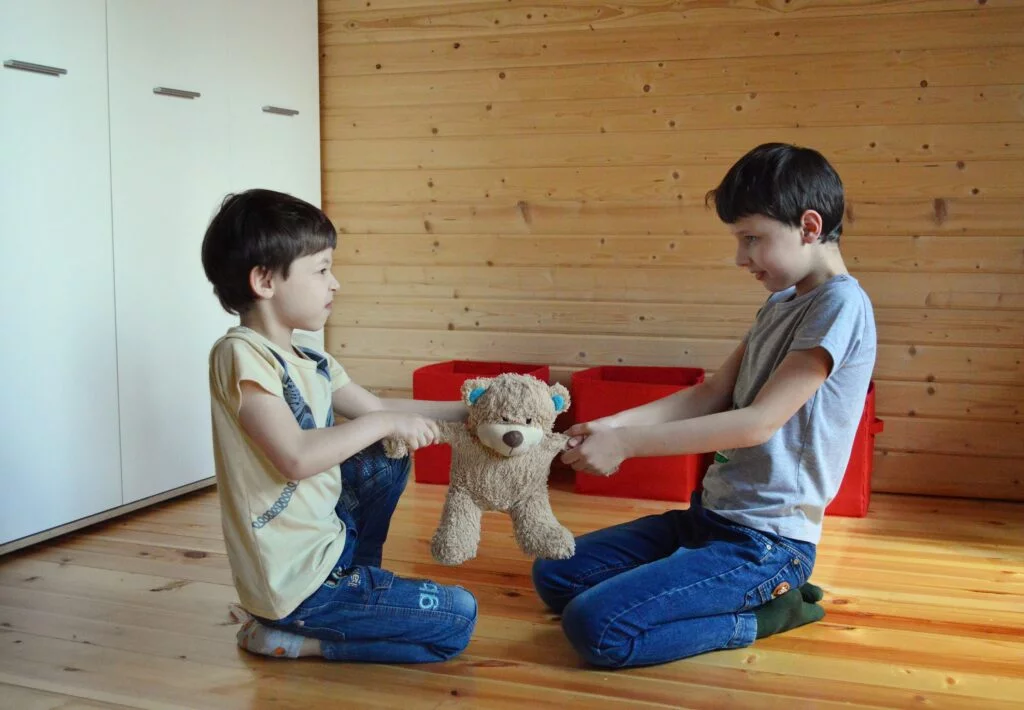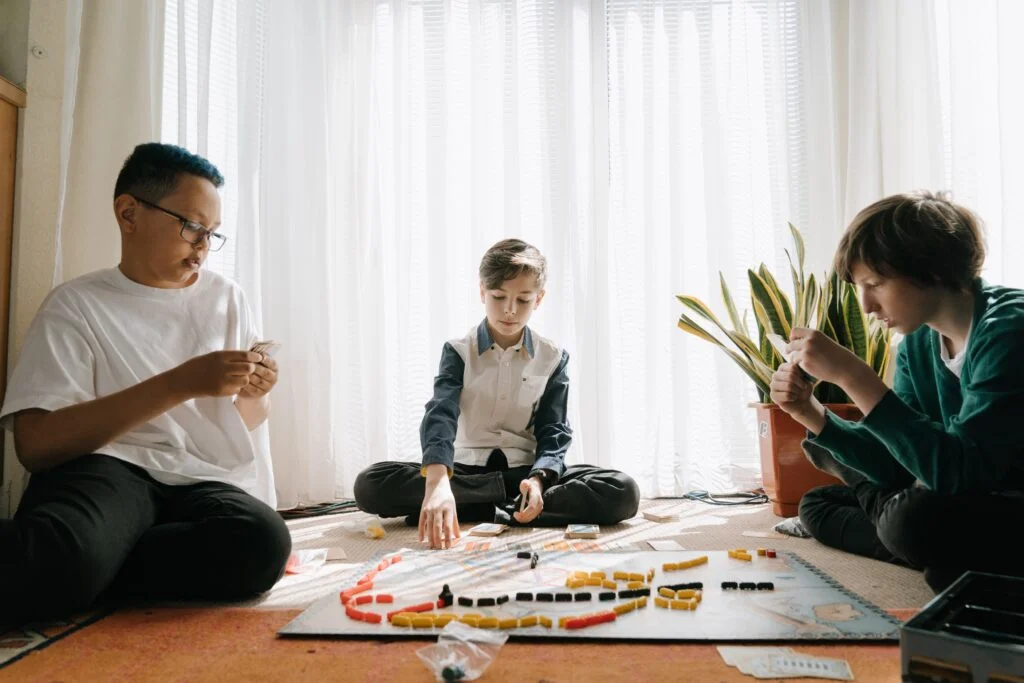Do you ever find yourself wondering, “How do you encourage children to share?”
Navigating the world of toddler tantrums over sharing a toy? Or the solitary journey of an only child learning to share? You’re not alone. Teaching children to share can feel like a mountain to climb, but it’s also a golden chance to foster empathy and cooperation.
In this article, we’ll journey through this exciting terrain, armed with effective strategies, practical tips, and fun-filled activities. We’ll answer the question that’s on the minds of many parents and educators: How do you encourage children to share? So let’s dive in!

Some of the links in this post are affiliate links. This means if you click on the link and purchase the item, I will receive an affiliate commision at no extra cost to you. All opinions remain my own. Read more on our Privacy Policy Page
👉 >>> SIBLING BONDING GAMES AND ACTIVITIES
The Why: Understanding the Importance of Sharing
Before delving into the how, let’s first explore the why.
Why is it so vital to encourage children to share?
Sharing, at its core, is a social exchange that fosters positive relationships and mutual respect. It teaches children to be considerate of others, to understand their feelings, and to cultivate empathy.
Moreover, sharing promotes fairness and equality, principles that are essential for societal harmony.
It helps children understand that resources are often limited and that their actions can impact others.
The How: 8 Effective Strategies to Encourage Children to Share
So, how do you encourage children to share?
Let’s explore in greater detail how you encourage children to share. Teaching children to share might seem daunting, but there are proven strategies to guide them towards understanding and practicing this valuable social skill.

1. Lead By Example
Leading by example is one of the most effective ways to encourage children to share. Kids often imitate adult behavior. Therefore, showing them that sharing is a routine part of your life can significantly influence their attitudes towards sharing. This can be as simple as sharing a dessert with your partner or lending a helpful hand to a neighbor.
2. Teach Through Play
Children learn a lot through play, and this includes learning how to share. Organize play sessions with toys that lend themselves to sharing and teamwork. Games that require turns or collaborative play, such as board games or building blocks, are excellent ways to introduce and reinforce the concept of sharing.
3. Praise and Positive Reinforcement
Everyone likes to feel acknowledged for their good deeds, and children are no different. Praise them when they share, expressing how proud their actions make you feel. This positive reinforcement can encourage them to repeat the behavior. You could say something like, “I love how you shared your toys with your brother. That was really kind!”
4. Use Storytelling
Children’s stories and books often contain moral lessons, and those that include themes of sharing and generosity can effectively help convey the importance of sharing. Use these stories as springboards for discussions about sharing. Ask questions like, “How do you think Bear felt when Rabbit shared his honey?” to make children think about the emotions and consequences linked to sharing.
5. Practice Empathy and Perspective-Taking
Teaching children to empathize can help them understand why sharing is important. Help them see from another child’s perspective and how it might feel when someone doesn’t share with them. This understanding can motivate them to share with others.
6. Gradual Introduction
If a child is particularly resistant to sharing, start small and gradually increase sharing demands. Maybe they start by sharing their crayons, then a small toy, and eventually move on to larger or more favored items. This gradual approach can make the transition less overwhelming.
7. Create a Sharing Schedule
For items that are consistently causing disputes, creating a sharing schedule might be helpful. This can provide a structured and fair way to ensure everyone gets a turn, which can reduce conflicts and promote the practice of sharing.
8. Encourage Cooperative Activities
Cooperative activities that require teamwork can foster a sense of community and interdependence, which can naturally encourage sharing. These can include group art projects, team sports, or family tasks such as cooking a meal together.
In summary, teaching children to share is a multidimensional process that requires consistent effort and a mix of different strategies. Remember, the goal isn’t to enforce sharing as a strict rule, but to help children understand its value and encourage them to embrace sharing as a part of their interactions with others.
👉 >>> SIBLING BONDING GAMES AND ACTIVITIES
Navigating Challenges: What to Do When Children Resist Sharing
Resistance to sharing is a common hurdle.
So, what should you do when children resist sharing?
The first step is to remain calm and patient. Remember, sharing is a complex concept for young children to grasp. It may take time for them to understand and be comfortable with it.
Next, facilitate a conversation about their feelings and why they might not want to share. Is it because they are afraid? Do they feel that it’s unfair? Understanding their perspective can help you address their concerns and guide them towards sharing.
The When: Timing and Developmental Stages
Teaching children to share is not just about the how but also about the when.
Developmental psychologists suggest that the concept of sharing is typically understood by children between the ages of 3 and 5. However, the actual act of sharing willingly and comfortably often develops later, around age 7 or 8.
Therefore, it’s important to introduce the concept of sharing at an appropriate age but also to be patient and allow children to develop this skill at their own pace.
The Journey: Encouraging Consistent Sharing
Now that we’ve discussed the why, the how, and the when, let’s discuss the journey of encouraging consistent sharing.
Encouraging children to share is a process, not an event. It requires continuous efforts, repetition, and reinforcement.
Praise and rewards can be useful tools in this journey. Acknowledge children’s efforts to share, even if it’s just a small action. This will encourage them to repeat this behavior in the future.
In conclusion, encouraging children to share is an essential part of their social development. It’s a journey that requires patience, understanding, and consistency. By leading by example, providing opportunities for sharing, and nurturing an environment that values sharing, you can effectively encourage children to adopt this crucial life skill.
The Sibling Scenario: Teaching Brothers and Sisters to Share
When it comes to teaching siblings to share, the challenge intensifies. The rivalry that sometimes accompanies sibling relationships can make this task even more complex. So, how do you teach siblings to share?
One effective strategy is to establish clear household rules that promote sharing. For example, implementing a rule where toys are communal and belong to everyone in the house, not just one person. This can help children understand that sharing is a natural part of family life.
However, this may not always work if, say, a 3-year-old won’t share with a sibling. In such a case, parents should step in and mediate, helping the children understand the importance of sharing, taking turns, and treating each other kindly.
What to Do When Siblings Don’t Share?
- Stay Calm and Objective
- Facilitate Communication
- Encourage Problem-Solving
- Use Time as a Tool
- Consistent Consequences
- Reinforce Positive Behavior

It’s a common scene in many households: siblings arguing over a toy, each claiming ownership, neither willing to share. When faced with this scenario, it can be challenging to know what to do. However, with the right approach, these conflicts can be transformed into opportunities for teaching important life lessons.
Stay Calm and Objective
First and foremost, maintain your calm. Disputes over sharing can be emotionally charged, but it’s crucial to keep your emotions in check. Approach the situation as an objective mediator, and avoid taking sides. Remember, your role here is to facilitate a resolution and teach valuable lessons about sharing.
Facilitate Communication
Encourage your children to express their feelings and thoughts about the situation. Ask open-ended questions to help them articulate their perspectives, like “Why do you think it’s hard to share this toy?” or “How do you feel when your sibling doesn’t share with you?”
Understanding their viewpoints can help you guide the conversation and teach the importance of sharing. Plus, it encourages your children to communicate their feelings constructively, which is a critical skill in itself.
Encourage Problem-Solving
Involve your children in the problem-solving process. After understanding their viewpoints, ask them what they think would be a fair solution. This process encourages them to think critically about the situation and consider their sibling’s perspective.
Use Time as a Tool
In some cases, using a timer can be an effective way to ensure equal sharing. If your children are fighting over a toy, set a timer for each child to have their turn. This not only ensures fairness but also helps children understand that sharing doesn’t mean giving up something forever.
Consistent Consequences
If one child consistently refuses to share, it’s crucial to implement consistent consequences. This might involve losing privilege over the disputed toy or having a time-out to reflect on their actions. The key is consistency – this helps children understand the consequences of not sharing and encourages them to make better choices.
Reinforce Positive Behavior
When your children do share, make sure to acknowledge it. Positive reinforcement can go a long way in encouraging good behavior. It could be a simple statement like “I noticed how you shared your toy car with your brother, that was very generous!” or a high five.
In conclusion, when siblings don’t share, it can be an opportunity to instill important lessons about sharing, empathy, communication, and fairness. Remember, patience is crucial in this process – these lessons take time to be internalized, but with consistent effort, your children can learn to share and build stronger bonds with each other.
The Solo Scenario: How to Teach an Only Child to Share
Teaching an only child to share presents its unique set of challenges. Unlike siblings who have inbuilt opportunities to practice sharing, only children often have to navigate this social skill outside the home, with friends or classmates. However, with strategic planning and a little creativity, parents can successfully teach their only child to share.
Role Play: Imaginative Sharing Scenarios
Role-play can be a fantastic tool for teaching an only child to share. By engaging in pretend play, you can create scenarios that call for sharing and demonstrate how to respond. You could set up a pretend picnic where both of you have to share the food items, or a pretend school where classmates need to share stationery.
Play Dates: Real-life Sharing Opportunities
Regular playdates provide an only child with real-life opportunities to practice sharing. During these interactions, they will inevitably encounter situations that require sharing. Guiding them through these experiences can be a practical way to teach them about sharing.
Lead by Example: Demonstrative Sharing
As with all children, only children learn a great deal from observing their parents’ actions. Make it a point to exhibit sharing behavior in your everyday life. When you share things or actions, talk about what you are doing and why it’s important.
Use Children’s Stories and Media
Stories, cartoons, and educational programs often contain messages about sharing. Use these resources to initiate conversations about sharing. After reading a book or watching a show, discuss the characters’ sharing behavior and ask your child how they felt about it.
Make Sharing a Game
Turning sharing into a game can make it enjoyable for an only child. Games like “Pass the Parcel” or other turn-taking games can be fun ways to incorporate sharing into your child’s routine.
Be Patient and Consistent
Remember that learning to share is a process, and it requires patience. Praise your child when they share and gently guide them when they struggle. Over time, with consistent guidance, your only child will become more comfortable with sharing.
In conclusion, teaching an only child to share requires creating opportunities for them to practice this skill. Whether through role-playing, playdates, storytelling, or games, parents can help their only child understand and embrace the importance of sharing. Just remember, it’s a journey, not a race, so be patient and consistent in your efforts.
👉 >>> SIBLING BONDING GAMES AND ACTIVITIES
7 Activities to Promote Sharing and Turn Taking
When it comes to teaching children about sharing, the adage “show, don’t tell” holds true. By engaging children in fun activities that promote sharing and turn-taking, parents and educators can provide them with practical, hands-on learning experiences. Below are a few engaging activities designed to do just that.

1. Board Games and Card Games
Board games and card games naturally involve sharing and turn-taking. Games like Candy Land, Uno, or Chutes and Ladders are perfect for this. They not only teach kids how to wait for their turn, but they also encourage sharing the game pieces and playing space.
2. Role-playing Games
Role-playing games can be a fun way to teach sharing and turn-taking. For example, you could set up a pretend play scenario like a ‘cooking show’ where each child gets a turn to be the chef and others share the ingredients.
3. Sharing Circle
A sharing circle is an activity where a group of children sit in a circle and share something one by one. This could be anything from sharing a toy, a story, or thoughts about a topic. This activity promotes turn-taking and gives each child an opportunity to be both the sharer and the receiver.
4. Musical Instruments
Hand out musical instruments and create a “band” where each child gets a chance to be the lead player. The rest of the group has to accompany the lead by playing softly. Rotate the lead role to ensure everyone gets a turn.
5. Ball Games
Simple ball games can be excellent for teaching turn-taking. You can play a game where children have to pass the ball to each other in a circle or throw it to each other in no particular order. The key is to encourage children to wait for their turn and share the ball.
6. Art Projects
Collaborative art projects are an excellent way to promote sharing and turn-taking. For instance, a large mural that all children contribute to requires sharing paints, brushes, and space. Another option could be a crafting project where children need to share materials and tools.
7. Reading Time
A shared reading session can promote turn-taking. One child could be tasked with turning the pages, while others could take turns reading aloud or pointing out objects in the pictures.
These activities can make the learning process interactive, practical, and fun. Remember, the objective is to provide children with a safe and encouraging environment where they can learn the importance of sharing and taking turns. Over time, with consistent practice, these skills will become ingrained, paving the way for healthy social interactions in the future.
Conclusion
Teaching children to share is more than just a lesson in etiquette. It’s about fostering empathy, building strong relationships, and equipping our young ones with critical social skills that will serve them well throughout their lives. Whether it’s siblings struggling to share a favorite toy, an only child navigating social situations, or educators looking for innovative ways to promote sharing in classrooms, we can all play a part in cultivating the art of sharing.
So, let’s lead by example and show the children in our lives that sharing is a natural part of our interactions with others. Let’s turn sharing into a fun game, an imaginative role-play scenario, or an exciting group project. And let’s remember to stay patient and consistent, offering praise when they share well and guidance when they find it difficult.
👉 >>> SIBLING BONDING GAMES AND ACTIVITIES
references: Mine or yours? Development of sharing in toddlers in relation to ownership understanding ( https://pubmed.ncbi.nlm.nih.gov/23145536/),







Pingback: When Toddlers Fight Over a Toy: Simple Parenting Tips - SiblingVibes